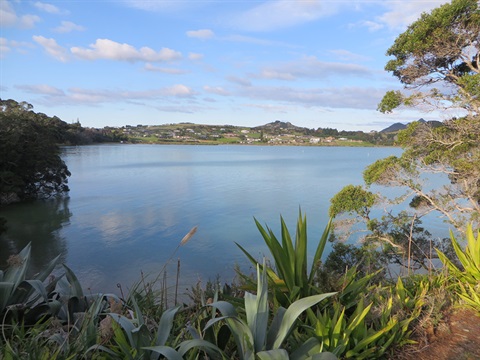Addressing wastewater challenges in Parua Bay
Published on 27 May 2025

We are taking steps to address stormwater inflow into the wastewater network at Parua Bay, with a pilot study to help identify the sources of the issues having been recently completed.
The study is among many waters projects being carried out by Council to help maintain Whangarei's high standard of water and wastewater systems as the District grows and weather patterns change.
Wastewater systems are designed to take the wastewater, which comes from showers, baths, washing machines, toilets and other household or business sources, from the property to a wastewater treatment plant, where it is treated before being disposed of.
Whangarei District Council Wastewater Engineer Paul Alexander says, "When stormwater enters the wastewater system it can lead to overflows, which is what we've seen in recent years at the storage tank on the corner of Ritchie Road and Whangārei Heads Road.
"Our investigations tell us that, during rain events, flows within the Parua Bay wastewater network sometimes increase by over eight times more than average daily dry weather flows."
The pilot study, undertaken to determine where stormwater is entering the wastewater network in Parua Bay, focused on the area immediately upstream of the storage tank, where the majority of connected Parua Bay properties are located.
Data from the study has been entered into a digital GIS (Geographic Information System) model, providing rich information about the wastewater system in the area and enabling informed solutions. Issues within the public network, as well as on some private properties, have been identified.
Smoke testing revealed remedial work is required at various manholes on public and private land, including sealing and repairing lids, particularly those located in low-lying areas that are susceptible to flooding.
Evidence of H2S attack has also been found, which is where a build-up of hydrogen sulfide causes corrosion of a manhole's walls, making them vulnerable to stormwater and groundwater leaking into them.
We are now preparing a programme of work to address these issues, and remediation is expected to take place over the coming months by our stormwater and wastewater maintenance contractor.
We have also engaged with the owners of properties within the pilot study area through surveys and site visits, to explore whether stormwater could be entering gully traps from downpipes, which ultimately feed into the wastewater network.
"While most gully traps on private property are in good condition, there are some that are damaged, incorrectly sealed or set too low, making them susceptible to stormwater inflow.
"Others are located in areas that are prone to flooding and could be overtopped in rainfall events, and some properties also have stormwater being directed into gully traps via downpipes," says Paul.
We will be following up with these property owners over the next three months to help ensure these issues are corrected.
"We appreciate the cooperation of the Parua Bay community throughout our investigations and will continue to monitor the situation and prevent spills in the meantime."
Further investigations are now planned near Taurikura after flow meters detected significantly increased flow coming from this catchment during recent heavy rainfall.